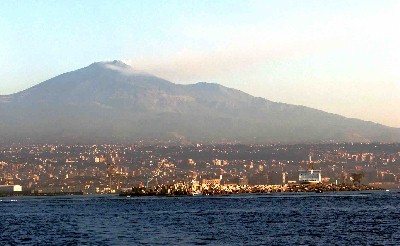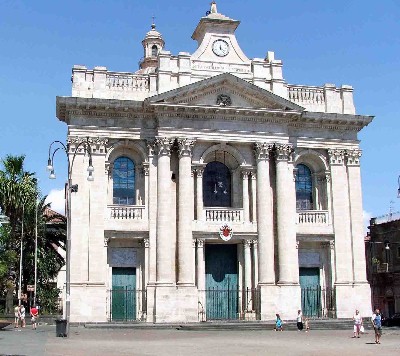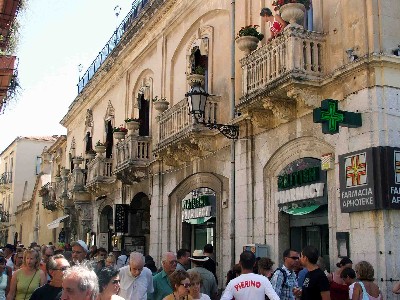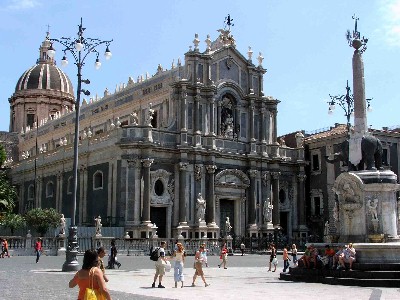 |
 |
 |
 |
Mount Etna is Europe's largest active volcano, and on a
clear morning you can see the smoke pouring out of its summit. Etna
eruptions have been responsible for destroying the surrounding towns, whose
citizenry dutifully rebuilds and flourishes until the next dousing. In
exchange, the volcano provides lava for building materials, and Sicily's
agriculture enjoys the resulting rich soil. The day we visited Etna was cool and windy, and the funicular ride to higher elevations was simply closed down. We took a Jeep instead, and watched the tram cars swinging about, happy that we weren't aboard. |
| Riposto was our first stop in Sicily, a town so unassuming that it didn't show up in either of our two guidebooks. But it's the beginning point for the train that circumnavigates Mount Etna, and it's a great place to see locals spending their August vacation in their own town and in their own way. Many nights, the courtyard in front of Saint Peter's Church was filled with spectators on folding chairs watching any of a flurry of summer entertainment: comedy, dance, or music. It's also a good starting point for day trips to Mount Etna or nearby Taormina. |  |
 |
Taormina, unlike Riposto, is a vacationer magnet, drawing
beachgoers and excursions from cruise ships. The town sits atop a mountain
ridge, accessible from sea level by traversing a zigzagging road alongside
huge stone villas protected by huge stone walls softened by bougainvillea
and other foliage.
Like a person who is famous for being famous, Taormina doesn't have exceptional historical significance. There are Greek ruins and many medieval and later buildings in Taormina, but that's not uncommon in the region. The lovely old buildings are filled with shops and cafés, and there's a funicular that takes you to the beaches below. |
| Catania experienced one of Mount Etna's worst eruptions in 1669 and was completely destroyed by an earthquake in 1693. The rebuilding from that earthquake covered the town in exquisite baroque architecture made from lava and limestone. Here in the main square, Piazza Duomo, are the Cathedral (dedicated to the city's patron saint, Sant'Agata) and Catania's symbol, the elephant with an obelisk on its back. The elephant, of course, is in lava, and the obelisk was brought from Egypt. So famous was this monument that the Arabs referred to Catania as "the city of the elephant." Napoleon, too, was fond of the elephant coupled with an obelisk and incorporated the concept into several Paris buildings. |  |